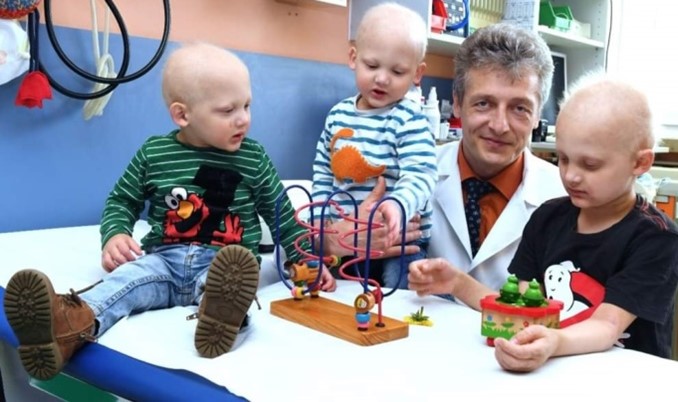The news our National Foundation for Ectodermal Dysplasias (NFED) family has been waiting patiently to hear has arrived! The EspeRare Foundation and Pierre Fabre Group announced the start of the EDELIFE clinical trial for x-linked hypohidrotic ectodermal dysplasia (XLHED). The trial’s purpose is to confirm the safety and efficacy of ER-004, which is a prenatal treatment that improves XLHED symptoms.
For 30+ years, the NFED has led the XLHED research which has brought us to this pivotal clinical trial. EDELIFE brings us closer to our dream: the first approved treatment for XLHED. And to think, it could happen in the next five years. Extraordinary!
We have been working closely with EspeRare and Pierre Fabre for several years to help support their efforts. Caroline Kant is the CEO of the EspeRare Foundation, which is a primary sponsor of the study.
Starting patient enrollment in the EDELIFE clinical trial is a huge milestone for the hypohidrotic ectodermal dysplasia community. Administered during the second and third trimesters of pregnancy, ER-004 has the potential to become a ‘single-course treatment,’ which significantly improves the symptoms of this debilitating disease throughout the lives of patients. If successful, ER004 could fundamentally change the lives of these patients and may also pave the way for other prenatal therapies to correct genetic diseases before birth.
– Caroline Kant
How The XLHED Clinical Trial Works
Investigators will study ER-004 in 15-20 male babies who have a confirmed XLHED diagnosis. ER-004 is a protein that was developed in a lab to replace the function of a protein called ectodysplasin A1 (EDA1), which is missing in individuals affected by XLHED. EDA1 is key to the normal development of ectodermal structures such as sweat glands, salivary glands, meibomian glands, teeth and hair. ER-004 is an intra-amniotic therapy that is administered while the baby is in utero.

If you have been following our updates, you know ER-004 shows great potential. Three baby boys with XLHED developed normal sweat glands after being treated with ER004 in utero by Dr. Holm Schneider. The promising results were published in the New England Journal of Medicine and in the British Journal of Clinical Pharmacology. Last August, the United States Food and Drug Administration gave ER-004 a breakthrough therapy designation, meaning it would be fast-tracked. Its clinical development also benefits from the European Medical Agency’s (EMA) PRIME (PRIority MEdicines) program.
Study Sites
EDELIFE is now open in Germany at the University Hospital of Erlangen with Dr. Schneider. Additional sites will open in 2022 in the United States (two locations), France, Italy, Spain and the United Kingdom.
According to Pierre Fabre’s CEO, Eric Ducournau, they can help families with the expenses of traveling to one of the study locations.
The EDELIFE study truly exemplifies Pierre Fabre’s commitment to supporting those with rare dermatologic diseases as we have already done in infantile hemangiomas. Our priority is to enroll 20 pregnant women with a confirmed diagnosis of XLHED in the fetus. As this is a very rare condition, together with the patient community, we are doing everything we can to support these women participate in the study, including helping them travel to a nearby country if there is no open investigational site in their own country.”
– Eric Ducournau
Learn More About the Study
If you are a woman (18 or older) who is an XLHED carrier and is pregnant or is planning to be pregnant in the next two years, you may want to learn more about the trial now. Timing is critical since the treatment must be given during a small window during pregnancy. You can learn more by downloading our EDELIFE flyer or visiting the study’s dedicated web site or clinicaltrials.gov.
Download EDELIFE FlyerPlease share information about EDELIFE with any other females in your family who may be carriers of XLHED. We often talk about the importance of genetic testing and this clinical trial is a good example of why. Women must have a genetic test confirming they have XLHED to be eligible for the study.
You can also read Emily Nelson’s story about traveling to Germany to have her son receive ER-004 in utero and how it’s impacted his life. If you are interested in joining the study or have more questions, please contact me at mary@nfed.org or 618-566-2020.
Contact Mary FeteXLHED Clinical Trial Follow-Up
Families who participate in the clinical study can expect follow-up assessments for five years. Initially, investigators will follow the treated boys until they are six months old. They will assess the mother’s safety up to one month after the child’s birth.The follow-up phase will follow the treated boys until they are five-years-old. Investigators will compare the treated boys’ ability to sweat to that of an untreated, unaffected relative if possible, or to that of a person from a control group who has the same genetic change on the gene causing XLHED. They expect for the trial to continue through 2025.
The follow-up phase will follow the treated boys until they are five-years-old. Investigators will compare the treated boys’ ability to sweat to that of an untreated, unaffected relative if possible, or to that of a person from a control group who has the same genetic change on the gene causing XLHED. They expect for the trial to continue through 2025.
Let’s Give Thanks!
We will continue to share information with you about the trial as we receive it. But, for now, we hope you will us in giving thanks for hitting this major milestone! It’s huge for our XLHED families and for all of us in the ectodermal dysplasias community.
Ectodermal dysplasia can cause a lifetime of challenges. By supporting research, you expand early diagnostics, treatments, pathways toward cures… and hope!Shape Our Futures With Research

My daughter in law is pregnant. My son has ED. During what stage of pregnancy do they do this.
Hi, Janet!
Mothers need to be in their second trimester (18-23 weeks) and expecting a boy to participate in the trial. However, because this trial only treat XLHED, if your daughter-in-law has a son, he will not be affected if only his dad is affected and mom isn’t. If your son has XLHED, then he could pass it on to a daughter, and she would most-likely be a carrier. There are a lot of genetics involved, and if your daughter-in-law is interested in learning more and to confirm if she is eligible to participate, I highly recommend she reach out to our executive director, Mary Fete, at mary@nfed.org. In the meantime, to learn more about inheritance patterns, check out this webpage: https://nfed.org/learn/genetics-inheritance/. For this trial, specifically refer to the chart about x-linked recessive inheritance. I hope this information helps! Thanks – Veronica